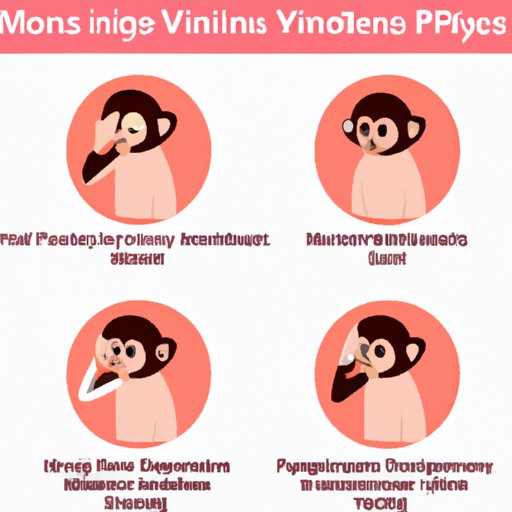
I. Introduction
Monkey pox is a rare but potentially dangerous viral infection that has recently made headlines due to a few isolated outbreaks. It is important to know the symptoms of monkey pox to be able to identify it and take appropriate measures to control its spread. In this article, we’ll explore the top 5 symptoms of monkey pox, how to differentiate it from other viral infections, how to identify and report it in your community, ways to treat symptoms at home, and the importance of keeping yourself and your family safe through prevention and vaccination.
II. Top 5 symptoms of monkey pox
Monkey pox symptoms start with a fever, followed by a rash that spreads over the body. Other symptoms include muscle aches, headache, and swollen lymph nodes. Here’s an overview of each:
- High fever: The fever typically starts abruptly and can last for 1-2 weeks. The temperature can go up to 104°F (40°C) or higher.
- Skin rash: The rash usually appears on the face before spreading to the trunk, limbs, and palms and soles of the feet. The rash can evolve into blister-like lesions that scab over and fall off in 2-4 weeks.
- Muscle aches: You may experience muscle pain and stiffness, particularly in the neck, back, and legs.
- Headache: The headache can be severe and persistent.
- Swollen lymph nodes: You may develop painful swellings of the lymph nodes, particularly in the groin, armpit, and neck.

III. Differentiating monkey pox symptoms from other viral infections
Several viral infections can cause similar symptoms to monkey pox, such as chickenpox, shingles, and smallpox. Here are some ways to tell the difference:
- Chickenpox: Chickenpox lesions are typically smaller, more numerous, and appear in different stages of healing. Chickenpox usually appears in children unless they have never had a chance to get vaccinated or been exposed to the virus. People can usually get vaccinated with the varicella vaccine to prevent chickenpox.
- Shingles: Shingles occurs in adults who have previously had chickenpox, with the virus reactivating to cause a painful rash and blisters. Shingles is commonly characterized by a painful, burning sensation on one side of the body.
- Smallpox: Smallpox was declared eradicated in 1980, but a few stockpiles kept in labs are maintained for research. If someone has smallpox, it will cause a rash with blisters and sores that later crust over. A hallmark of smallpox is the lesions and sores that appear almost everywhere on the body.
IV. Identifying and reporting monkey pox symptoms in your community
Reporting monkey pox symptoms to health authorities is vital to prevent or contain outbreaks. Here are some steps you can take to identify and report symptoms in yourself and others:
- The importance of reporting: If you think you or someone else has monkey pox, report it to your local health department immediately. They can provide guidance on treatment and prevention measures and help track the spread of the illness.
- How to identify symptoms in yourself and others: Be aware of the symptoms and risk factors for monkey pox, such as recent travel to an affected region or contact with an infected animal or human. If you or someone you know has symptoms consistent with monkey pox, seek medical attention or contact your local health department as soon as possible. Laboratory testing and isolation of patients with monkey pox are required to confirm a diagnosis.
- Steps to take if you suspect monkey pox in your community: If monkey pox is confirmed in your area, follow recommendations from local health authorities for quarantine, vaccination, and other preventive measures to avoid further spread. Avoid close contact with anyone who is infected and report any new cases or suspected contacts to health authorities.
V. Treating monkey pox symptoms at home
There is no specific treatment for monkey pox, but you can manage the symptoms at home through rest and fluids. Here are some tips:
- Managing symptoms through rest and fluids: Getting plenty of rest and fluids can help ease fever and other symptoms. It can also help prevent dehydration, which can lead to complications, such as kidney failure.
- Over-the-counter medication for pain relief: Over-the-counter painkillers, such as acetaminophen or ibuprofen, can help relieve the muscle pain, headache, and fever. Do not give aspirin to children and teenagers because of the risk of Reye’s syndrome.
- When to seek medical attention: Seek medical attention if you or someone you know has severe or worsening symptoms, such as difficulty breathing, an altered mental state, or bleeding. These are signs of possible complications, which can be life-threatening. Antibiotics and other supportive care may also be prescribed by medical professionals.
VI. How to keep yourself and your family safe from monkey pox
Prevention is key when it comes to monkey pox. Here are some tips to keep yourself and your family safe:
- Prevention tips: Avoid contact with wild or exotic animals, especially rodents, primates, and squirrels, which can carry the virus. Cook meat thoroughly and wash your hands frequently.
- Understanding how monkey pox spreads: Monkey pox can spread from animals to humans through bites, scratches, or direct contact with infected bodily fluids or materials, such as bedding or clothing. Transmission can also occur between humans through respiratory droplets or contact with skin lesions.
- Importance of vaccination: Vaccination is the best way to protect against monkey pox. The smallpox vaccine provides immunity against monkey pox, but it is no longer routinely administered because smallpox is eliminated. Some countries have stockpiled the vaccine for emergency use. Consult with healthcare providers for information on the vaccine availability in your area.
VII. Coping with the psychological and emotional impact of monkey pox
Dealing with illness can be stressful and challenging, and monkey pox is no exception. Here are some tips to help manage the psychological and emotional impact of monkey pox:
- Dealing with the stigma surrounding the illness: There is a lot of stigma and fear surrounding infectious diseases, which can lead to discrimination and social isolation. Try to educate others about monkey pox and emphasize that anyone can become infected.
- Self-care tips for managing stress and anxiety: Take care of your mental and physical health by getting enough sleep, eating nutritious food, exercising, and practicing stress-reducing activities, such as mindfulness meditation or yoga. Reach out to friends and family for support, or consider speaking with a mental health professional if you feel overwhelmed.
VIII. Vaccines and staying vigilant against monkey pox
The controversy surrounding existing vaccines and their safety is a hot topic, but staying informed and taking precautions can help alleviate concerns. Here are some ways to stay vigilant:
- The controversy surrounding existing vaccines: The vaccine controversies and hesitancy regarding vaccines to prevent monkey pox and other diseases have arisen over the years. Consult with healthcare providers to separate vaccine fact from fiction and understand the best course of action for your individual health needs.
- Staying informed and taking precautions: Stay informed about any outbreaks of monkey pox in your area, and follow the guidelines and recommendations of public health officials. Take appropriate measures to stay safe, such as avoiding nonessential travel to affected areas, practicing good hygiene, and following preventive measures whether or not you have been vaccinated.
IX. Conclusion
Knowing the symptoms of monkey pox and taking preventive measures are essential to avoid spreading the virus and protect yourself and your loved ones. By identifying and reporting monkey pox in your community and taking steps to manage the symptoms, you can help reduce the risk of serious complications. Remember to stay informed, stay vigilant, and stay safe.




